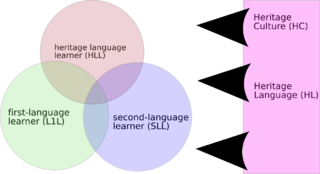Related Research Articles

An endangered language or moribund language is a language that is at risk of disappearing as its speakers die out or shift to speaking other languages. Language loss occurs when the language has no more native speakers and becomes a "dead language". If no one can speak the language at all, it becomes an "extinct language". A dead language may still be studied through recordings or writings, but it is still dead or extinct unless there are fluent speakers. Although languages have always become extinct throughout human history, they are currently dying at an accelerated rate because of globalization, imperialism, neocolonialism and linguicide.

Champenois is a Romance language of the langues d'oïl language family spoken by a minority of people in Champagne and Île-de-France provinces in France, as well as in a handful of towns in southern Belgium.
The Bung language is a nearly extinct, endangered language of Cameroon spoken by three people at the village of Boung on the Adamawa Plateau. It is remembered best by one speaker who learned the language at a young age, though it is not his mother tongue. A wordlist shows its strongest resemblance to be with the Ndung dialect of Mambiloid language Kwanja, although that may simply be because this has become the dominant language of the village where Bung's last speakers reside. It also has words in common with other Mambiloid languages such as Tep, Somyev and Vute, while a number of words' origins remain unclear. For lack of data, it is not definitively classified.
The Sansi language, Sansiboli, or Bhilki, is a highly endangered Indo-Aryan language of the Central group. The language is spoken by the nomadic Sansi people.
Xipaya is an endangered language spoken in the Pará region of Brazil.
Moloko (Məlokwo) is an Afro-Asiatic language spoken in northern Cameroon.

The Siberian Turkic or Northeastern Common Turkic languages, are a sub-branch of the Turkic language family. The following table is based upon the classification scheme presented by Lars Johanson (1998).
The Nunusaku languages are a group of Malayo-Polynesian languages, spoken on and around the island of Seram. None of the languages have more than about twenty thousand speakers, and several are endangered with extinction.
The Brokkat language is an endangered Southern Tibetic language spoken by about 300 people in the village of Dhur in Bumthang Valley of Bumthang District in central Bhutan. Brokkat is spoken by descendants of pastoral yakherd communities.

Dusner is a language spoken in the village of Dusner in the province of Papua, Indonesia. Dusner is highly endangered, and has been reported to have just three remaining speakers.
Iyasa is a Bantu language spoken in Cameroon and Equatorial Guinea by the Iyasa and Ndowe coastal fishing peoples. It is also spoken by Pygmies, perhaps Babongo, in Gabon. Approximately 3,000 people speak Iyasa, though some note that this number may be an overestimation.
Iyive, also referred to as Uive, Yiive, Ndir, Asumbos, is a severely endangered Bantoid language spoken in Nigeria and Cameroon. The ethnic group defined by use of this language is the Ndir.
Yandruwandha is an Australian Aboriginal language of the Pama–Nyungan family. Yawarawarga is considered a dialect by Dixon (2002), a closely related language by Bowern (2001). It is also known as Yawarrawarrka,Yawarawarka, Yawarawarga, Yawarawarka, Jauraworka, and Jawarawarka).
Yolŋu (Yolngu) or Murngin Sign Language is a ritual sign language used by the Yolngu, an Aboriginal community in the Arnhem Land region of Australia. As with other Australian Aboriginal sign languages, YSL was developed by the hearing for use when oral speech is forbidden, as during mourning or between certain family relations. However, "YSL is not a signed version of any spoken Yolngu language... YSL also serves as a primary means of communication for a number of deaf members in Yolngu communities... YSL functions as both an alternate and primary sign language". That is, it is used for communicating to the deaf, but also when communicating at a distance, when hunting, or when ceremonies require silence. It was acquired from birth by the hearing population. YSL is now considered an endangered language.
Mayi-Kulan is an extinct Mayi language formerly spoken on the Cape York Peninsula of Queensland, Australia.
Wik-Me'nh is a Paman language of the Cape York Peninsula of Queensland, Australia

Idalaka is a dialect chain spoken in East Timor. The dialects are spoken in the Ramelau mountains with the exception of endangered Lolein, which is spoken in Dili. Idalaka resembles the Kemak language in that there are archaic features such as personal prefixes in verbs. Idalaka is one of 15 recognized national languages of East Timor. The name is a portmanteau of Idaté and Lakalai.
Tonsawang, also known as Tombatu, is an Austronesian language of the northern tip of Sulawesi, Indonesia. It belongs to the Minahasan branch of the Philippine languages.
Lauje is a Celebic language of Sulawesi in Indonesia. Ampibabo, spoken in Ampibabo District, may be a separate language.
The Endangered Languages Project (ELP) is a worldwide collaboration between indigenous language organizations, linguists, institutions of higher education, and key industry partners to strengthen endangered languages. The foundation of the project is a website, which launched in June 2012.
References
- 1 2 Zangwal at Ethnologue (18th ed., 2015)
- ↑ Moseley, Christopher (2007). Encyclopedia of the World's Endangered Languages. Routledge. p. 627.